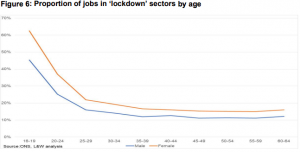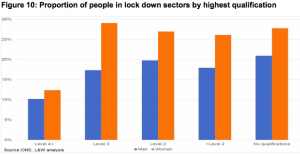The unequal impact on women in the workforce
By Tom Schuller
Date:
11 06 2020Authors:
Tagged by:
Share:
Other things being equal, it seems that men may be harder hit by coronavirus physically – a higher proportion are affected and die. If that’s in any way linked to genetic reasons it prompts a fairly hairy speculation about what will happen in the very likely event of future pandemics. But other things aren’t equal. For a start, women are more likely to be key workers, and therefore more exposed to health risks. It’s also been pretty clear for a while the economic impact will be tougher on women, at least in the first instance.
The Learning and Work Institute’s own analysis shows this clearly. At every age, and at every level of qualification, women are more likely to be working in sectors such as hospitality and retail that have been most affected by the crisis.


I have four reflections on this. The first, which I have not seen any commentary on, is that a gender-unbalanced impact of this kind will have an overall impact on the skill levels of the workforce. It’s true that care workers are generally not highly qualified – though we have learnt to be much more careful about equating qualifications and skills – but overall if women are shot out of employment, the competence levels of the workforce as a whole will drop.
Secondly, the shutting of schools and nurseries means more children in the house. We don’t have figures on how this has affected the division of parenting, but the effects could go in one of two directions (or possibly both…) It might be that mothers will do more of the locked-down caring and homeschooling, reinforcing traditional divisions. Or it might be that fathers will be less able to avoid sharing fully – or to put it more positively, dads will take to the new duties and this will have lasting effects on the household division of labour.
Thirdly, the debate on flexible working has obviously taken a whole new turn. I’m quite hopeful that this will mark a real break with the past on attitudes to flexible schedules, and we can get past the mental block which associates flexible working with peripheral roles in the organisation. Of course this will play out very differently in different organisations, but the mould is broken. Some of you may recall that this is a central component of the Paula Principle analysis.
Finally, ideas for radically new forms of welfare now have dramatically more chance of being taken seriously. Notably, the prospects for a Universal Basic Income – advocated for some time by organisations such as Compass and the RSA – have taken a big jump forward. Compass in particular has been doing more work on this, with a timely new report from Stewart Lansley. Several years ago when writing the PP, I was attracted by UBI mainly on the grounds that it helps women to move in and out of employment without rupturing their career prospects. Despite the claims of its most ardent proponents such as Guy Standing, I had then and retain now some doubts about its practicality, and am more inclined towards the emerging notion of Universal Basic Services championed by Anna Coote and others. But there’s no doubt that the debate is now there to be had, no longer the preserve of thinktank oddities.
Tom Schuller, author of The Paula Principle: why women lose out at work